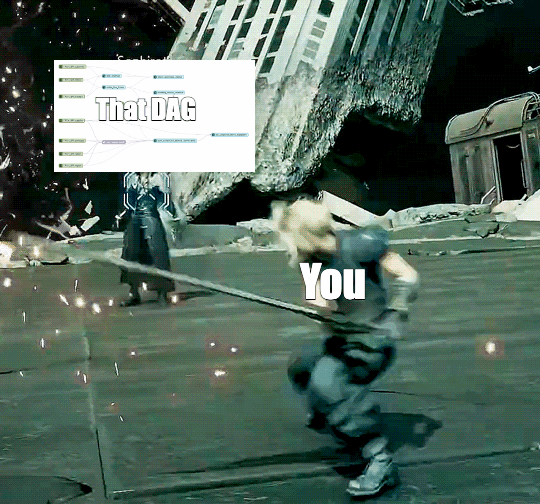Welcome to the Inherited Project Refactoring workshop of Coalesce 2022!
You've just started working at a new job and they've been using dbt to transform their data (YES!). However, once you've made it into their project, you realize that you can't make heads or tails of their data flows. Let's be honest - it's a messy project and you desperately want to form a plan for cleaning it up.
dbt's already got some great material out there regarding refactoring (if you want to start with hands-on-code refactoring, you can start with the refactoring course), but the road to get from where you are to where you need to be can be hard navigate unless you've traveled it numerous times. This refactoring workshop focuses on the roadmap for refactoring, and is the perfect start to getting that extra practice in!
Part of Christine and Lauren's day-to-day is taming those crazy projects - they've created this workshop to teach you the art of planning, show you some tips and tricks, and give you some leveling-up advice for wrangling those DAGs!
This workshop assumes that you're familiar with dbt. At a minimum you should know how to:
- Generate documentation
- Run commands and compile code
- Create branches
Live participants
For the workshop, you will be given access to the dbt Cloud account with all the necessary prerequisites.
All others
-
A Repository
Ideally, with the files and folders contained in this workshop. To make a copy, fork this repository. -
dbt
Using dbt Cloud vs. dbt Core doesn't matter. You'll specifically want to know how to:- install packages
- generate and view documentation
- use selection syntax
- upgrade your dbt version, if needed (This project uses v1.3)
To setup dbt:
-
Some Data
This project is written on top of BigQuery and uses the publicly available TPC-H data set. A truncated version of the data set has been included in this project as CSV files, located in the _resources folder.If you don't have some data or a warehouse yet, don't worry - the setup will guide you through setting up a free BigQuery account and loading the data for this project. Here are some resources to reference, just in case:
- Instructions for setting up a free BigQuery account
- Instructions for loading CSV files into BigQuery
- Starter instructions for accessing the TPC-H dataset yourself
Note:
We don't suggest seeding the CSV files. Though they are truncated, they still contain a significant amount of rows.
Live participants
-
Navigate to the
Coalesce 2022 Workshop - Refactoring dbt Cloudaccount. -
Configure your development credentials:
- Click on your user profile in the top left-hand corner and click
Profile Settings - Scroll to the "Credentials" section.
- Click on
Analytics - Hit the
Editbutton in the lower right hand corner. - Change these configurations:
Dataset Set this to dbt_your first initial + last name. Example:dbt_cbergerTarget Name Set this to dev- Hit
Save
- Click on your user profile in the top left-hand corner and click
-
Run
dbt depsto install dependencies. -
Confirm your setup:
- Navigate to the IDE by clicking on the
Developtab in the upper right-hand corner - Try running the following commands:
$ dbt run $ dbt testor alternatively:
$ dbt build
- Navigate to the IDE by clicking on the
All others
-
Set up your dbt Project
Important
If you don't set up the BigQuery account and want to use another warehouse:- You'll need a warehouse - the warehouse is an essential connection in dbt.
- You'll need to load the data to your selected warehouse using another method.
- You'll need to make changes to the repository code you forked so the syntax works with your warehouse.
-
Load the data
Download the files from the
_resources/tpch_dataset. If you are working locally, the files will be within the repository location on your computer.-
If you set up a BigQuery account during setup, load the data:
- In the BigQuery UI's
Explorerpane, click the three dots next to your project name - Click
Create dataset. - For
Dataset ID, typeraw_tpch. - Click
Create dataset - You should now see your dataset listed under your project name. Click the three dots next to the dataset.
- Click
Create table - Choose
Uploadas the Create table from option. - Click
BrowseunderSelect file - Upload each file you downloaded from the
_resources/tpch_datasetfolder:- For the table name, use the file name without the extension. Some file names have
_100mbappended. Omit this. - Make sure to check
Auto detectunder Schema
- For the table name, use the file name without the extension. Some file names have
- In the BigQuery UI's
-
If you didn't setup BigQuery, load the data from the
_resources/tpch_datasetinto your warehouse.
You will need to update the_sources.ymlfile with the location of your data.
-
-
Run
dbt depsto install dependencies. -
Confirm your setup:
Try running the following commands:$ dbt run $ dbt testor alternatively:
$ dbt build
Whoa... whoa there! You can't just go slinging at the DAG like that. Here's a walkthrough to get you trained up!
Live participants:
We're asking that you don't go hopping in to the walkthrough just yet! We'll be training together live! 💜
- Learn more about dbt in the docs
- Check out Discourse for commonly asked questions and answers
- Join the dbt community to learn from other analytics engineers
- Find dbt events near you
- Check out the blog for the latest news on dbt's development and best practices
